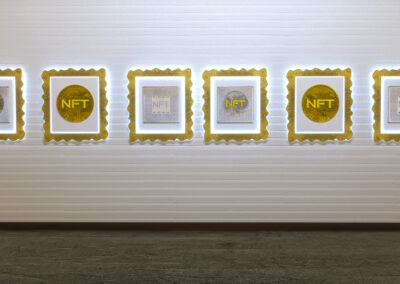NFTs coverage: a new challenge for the insurance world
A challenge we are ready to embrace at Schwegler Associated
In recent years, artists have found new ways of creating artworks, which in some cases have become immaterial. The use of the blockchain technology in the world of art determines new potential and changes the ways in which it is bought and sold, paid for and stored..
Digital artists benefit from its use because it helps reduce forgery, fraud, prove ownership and facilitate access to the secondary market. But at the same time, all this leads the collectors and operators of the various sectors of the art system (including the insurance one) to relate to completely new paradigms.
The motivation for most NFT investors is the long-term value potential of the NFT market and the chance to establish “social capital” which refers to the physical capital equivalent of owning a luxury watch or car. NFT projects and digital assets have created a community of individuals who use the marketplace to start brands, “flex” their social capital and link themselves with the crypto community.
With the recent advent of Metaverse, the digital world may be closer than we think, and investors do not want to be caught off guard, but…
How can they protect the value of their digital assets if standard insurance policies cover just material damage?
Until now, the only intangible items the insurance world came across with were audio or video files and the insurance policy was based on covering the costs of reproduction/recording of a new copy from the original. NFTs, however, are quite another thing and there are many doubts by the major market operators about their insurability in the artistic field.
The real challenge is ensuring an NFT is valuing it at a fair market price. Under a typical insurance policy, a fine art piece can be valued based on its purchase price but when it comes to an NFT, its value fluctuates rapidly. A point which has left many insurers hesitant to insure digital assets.
In general, the underlying problem seems to be the lack of interest from the insurers who today limit themselves to insuring only digital assets held by companies that do this professionally and that have greater internal controls/regulatory obligations and are therefore perceived as less risky.
On the other hand, there is no interest for the individual who holds a “hot wallet” as the risk of theft of NFT wallets stored in “hot storage” (online wallets connected to the network) is very high and the availability of insurance markets are very limited in terms of capacity and insurable amounts.
Different scenario in case of “cold storage”, which is less risky as the NFT wallets are not connected to the network and the risk is therefore of material theft. Regarding the “damage”, with the blockchain technology the digital assets cannot be destroyed, but at most they can be made inaccessible and this is a theoretically insurable risk.
In this scenario, the first to accept the challenge launched by NFTs to the insurance sector were YAS Digital Limited and the Hong Kong branch of Assicurazioni Generali S.p.A. that, on April 16th 2021, launched NFTY: a new insurance product that takes advantage of the growing popularity of the advanced blockchain technology to certify digital assets such as media, music, works of art and collectibles.
How can Schwegler Associated assist you?
Over many years we have had the confidence of the insurance market to determine procedures and safety systems for protecting artworks and valuables by high safety standards.
Now, with the introduction of a team of cybersecurity and blockchain experts, responsible for establishing guidelines and security measures for NFTs, and a new partnership with an IT security and service management company; We want to supply the same safety standards through a 360° service to safeguard both policyholders and insurers.
If you would like to know more and have a team of experts with over 30 years experience to assist you, we are here for you.
Sources:
- https://www.heffins.com/news-events/blog/insuring-nfts-can-you-protect-your-non-fungible-assets
- https://collezionedatiffany.com/nft-e-assicurabilita-delle-opere-darte/
BLOG





